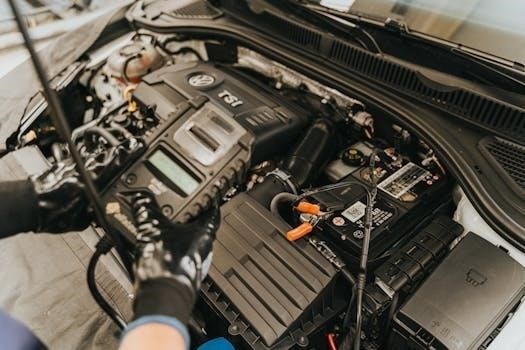This manual provides crucial safety and operating instructions for the Battery Tender Plus chargers. These chargers are designed for lead-acid batteries. They are fully automatic and can be left connected for extended periods. They maintain optimal storage voltage and prevent damage.
Overview of Battery Tender Plus Chargers
Battery Tender Plus chargers are designed for various six-cell lead-acid batteries, ranging from 1.2 to 200Ah. These chargers are fully automatic, making them suitable for long-term connections. They provide a 1.25 amp charging rate, which translates to approximately 1.25 amp-hours per hour. For instance, a 15 amp-hour battery will take roughly 10 hours to recharge to 80% capacity. The charger’s output power, voltage, and current adapt based on the battery’s condition. These chargers are available in models including 12V 5/2.5A and others. They are designed to fully charge a battery and maintain it at the correct storage voltage, preventing sulfation, a common issue with trickle chargers. Various models are available, such as the 12V 1.25A version and models for 6V batteries as well. They are designed to be left connected to the battery for long durations. This range of chargers is designed to accommodate a variety of lead-acid battery needs.

Safety Precautions
Before using the battery charger, it is crucial to carefully read all instructions. Avoid contact with battery acid. Ensure proper setup by inserting the charger’s plug into the wall socket. Do not use damaged or worn parts.
General Safety Rules Before Use
Prior to operating the Battery Tender Plus, it is imperative to thoroughly review the entire instruction manual. This will ensure safe and effective usage. Always avoid any contact with battery acid, as it can be corrosive and harmful. Before plugging the charger into a power outlet, ensure that the power pack is securely placed within the designated battery charger unit. Check all cords and connectors for any signs of wear or damage before each use; do not operate the charger if any parts appear to be compromised. This practice helps prevent potential electrical hazards and ensures proper functionality. These safety precautions are essential to minimize risks during the charging process.
Avoiding Contact with Battery Acid
Battery acid is a corrosive substance, and contact with skin, eyes, or clothing must be strictly avoided. Always wear appropriate protective gear, such as gloves and safety glasses, when handling batteries or working around them; If battery acid comes into contact with your skin, immediately flush the affected area with copious amounts of water and seek medical attention if necessary. Similarly, if acid gets in your eyes, rinse them thoroughly with water for at least fifteen minutes and get immediate medical help. Be sure to handle batteries with care and avoid spills during charging. Taking these precautions will help ensure your safety when using the Battery Tender Plus.

Operating Instructions
Before using the charger, carefully connect it to both the AC power and the battery. The charger operates automatically and adjusts its output based on the battery’s condition, ensuring safe and efficient charging.
Connecting to AC Power and Battery
Prior to initiating the charging process, it is essential to ensure that the Battery Tender Plus is correctly connected to both the AC power source and the battery. Begin by plugging the charger’s power cord into a suitable wall socket. Next, securely attach the charger’s output leads to the battery terminals, ensuring the positive (+) lead is connected to the positive terminal and the negative (-) lead to the negative terminal. Double-check these connections to avoid any reverse polarity issues. Once both connections are secure, the charger is ready to begin its automatic charging sequence. The charger will now analyze the battery’s condition and adjust the charging process accordingly. Remember, it is crucial to follow these steps carefully to ensure safe and efficient operation of the Battery Tender Plus charger.
Charging a Dead or Low Voltage Battery
The Battery Tender Plus is designed to handle dead or low voltage batteries effectively. When connected to a deeply discharged battery, the charger’s automatic system will assess the battery’s condition. It will then initiate a specialized charging mode that provides a low current charge to gently revive the battery. This process may take longer than charging a partially discharged battery. The charger will automatically adjust the charging rate as the battery recovers, ensuring that it is charged safely and efficiently. The charger’s microprocessor controls the charging process. It monitors the battery’s voltage and current, preventing overcharging and any potential damage. It is crucial to allow the charger sufficient time to fully charge a deeply discharged battery. The battery tender plus may take longer when charging such a battery.
Understanding Charging Rates and Times
The Battery Tender Plus charges at a rate of 1.25 amps, or 1.25 amp-hours per hour. This means a fully discharged 15 amp-hour battery will take approximately 10 hours to reach 80% capacity. Charging times vary based on the battery’s initial state of charge and its amp-hour rating. The charger automatically adjusts its output power, voltage, and current depending on the battery’s condition. A completely discharged battery will require longer charging times than one with a partial charge. The charger is designed to deliver a consistent charge. It will eventually switch to maintenance mode when the battery is fully charged. Different models may have varying amperage, which will affect the charging time. Always refer to the charger’s specifications for precise details.

Maintenance and Storage
Store the charger in a cool, dry place. Check the charger and cables daily for wear or damage. Do not use with damaged parts. Following these guidelines ensures safe and effective operation.
Proper Storage Conditions
To ensure the longevity and optimal performance of your Battery Tender Plus charger, it is crucial to adhere to specific storage guidelines. The ideal storage environment is a cool, dry place, away from excessive moisture and extreme temperatures. Avoid storing the charger in areas prone to humidity, as this can lead to internal component damage and corrosion. Moreover, keep the device away from direct sunlight and sources of heat, which may cause overheating and potential malfunction. When storing the charger, ensure that the cables are neatly coiled and not kinked or strained, as this can lead to damage over time. By following these storage recommendations, you can prolong the life of your Battery Tender Plus and ensure it is ready for use when you need it.
Checking Charger and Cables for Damage
Regular inspection of your Battery Tender Plus charger and its cables is essential for safe and efficient operation. Before each use, carefully examine the charger unit for any visible signs of damage, such as cracks, dents, or loose parts. Pay close attention to the power cord and charging cables, looking for fraying, cuts, or exposed wires. Ensure that the connectors are not bent or corroded. A damaged charger or cable can pose a significant safety risk, including electric shock or fire. If any damage is found, do not use the charger until the affected parts are replaced or repaired by a qualified technician. Routine checks will help ensure the reliable and safe performance of your Battery Tender Plus. Always prioritize safety when dealing with electrical equipment.

Features and Specifications
The Battery Tender Plus is compatible with lead-acid batteries. It offers automatic charging and maintenance. Different models vary in amperage. It fully charges and maintains batteries without causing sulfation, unlike some trickle chargers.
Compatibility with Lead-Acid Batteries
The Battery Tender Plus chargers are specifically engineered for use with six-cell lead-acid batteries, accommodating a wide range of capacities from 1.2 to 200Ah. These chargers are compatible with various types of lead-acid batteries, including flooded, AGM (Absorbent Glass Mat), and GEL cell batteries. The Battery Tender Plus ensures proper charging and maintenance for these battery types, preventing damage and extending battery life. It is essential to verify that your battery is within the specified range to ensure safe and effective charging. The charger’s automatic features adapt to the battery’s needs. This includes providing the correct voltage and current for optimal performance. Using the charger with other battery types may lead to malfunction or even damage.
Automatic Charging and Maintenance
The Battery Tender Plus chargers are fully automatic and designed to provide a seamless charging experience. These chargers can be left connected to both the AC power source and the battery for extended periods without risk of overcharging. The charger’s microprocessor intelligently manages the charging process, adapting to the battery’s condition. It delivers the correct voltage and current, ensuring optimal charging and maintenance. Once the battery is fully charged, the Battery Tender Plus automatically switches to a maintenance mode, preventing sulfation and maintaining the battery at its proper storage voltage. This automatic operation ensures that the battery remains in top condition, ready for use when needed. This feature eliminates the need for manual monitoring and adjustment.
Different Models and Amperage
Battery Tender Plus chargers are available in various models, each designed to cater to different battery types and charging needs. These models offer varying amperage outputs, including 1.25A, 2.5A, 5A, and 6A options, among others. The selection of the appropriate model and amperage is crucial for optimal battery charging and maintenance. For smaller batteries, like those found in motorcycles or lawnmowers, a lower amperage model like the 1.25A may be sufficient. Larger batteries in cars or trucks may require higher amperage chargers such as the 5A or 6A models. Selecting the right charger helps to ensure safe and efficient charging, preventing damage to the battery. Different models are designed for both 12V and 6V systems.